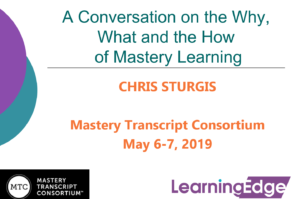
The following is the presentation and facilitated activities at a Mastery Transcript Consortium meeting held on May 6, 2019
This is the beginning of a conversation about the why, what, and how of Mastery Learning. The activities are designed so that you can take them home to your school and your team. We will be using them for just a bit so that you get a sense of the process and how it can help you develop conversations in your school to build understanding about mastery learning.
—
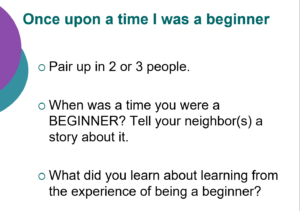
Before we dive into the why, what, and how of Mastery Learning, we are going to do a little warm-up.
Take a second and think back about a time you were a beginner. When did you last learn to do something new? Or perhaps you remember learning something in childhood? Turn to your neighbor so that you are in teams of 2 or 3 people. Tell them about that experience of being a beginner and share one thing as you reflect back on that experience about what you learned about learning.
You are all educators, so you probably know why I did this activity instead of starting to talk to you right away. The research on learning and development tell us that:
- Learning is a social process and that the quality of our relationships impact our learning.
- The nature of learning takes us out of comfort zone. If we are going to have to take some risks to learn something new, a sense of safety is going to be important. Since we are all learning about mastery-based learning, we know that we are going to feel vulnerable at times. We can help each other learn if we also taek responsibility to help create a strong sense of belonging and a sense of safety for everyone…today and when you return to your school.
It’s important that as adults we use the research on learning – that we all walk the talk – in everything we do.
—

You are all going to be doing the work today at your tables. Why? Because the research on learning also says I can only talk for about 7-10 minutes, and then you are going to start to starting tuning out a bit. After 20 minutes your working memory is going to be full up. You need a chance to process. So today is structured in that I’ll review some core ideas and then there will be an activity.
To make this run all smoothly, I am going to go over a few things.
First, everything I’m going to say is on a blog at LearningEdge.me. So don’t worry about taking notes, you can always refer to the article. Stay focused on your own ideas and questions.
Second, you’ll be self-organizing. So I’ll be asking 3 of you to volunteer for the roles of scribe, timekeeper, and facilitator.
Third, you have some materials on your tables. There are some handouts on my slides, but I want you to be able to read them. There are 3 templates that we will be using to capture your ideas. And we are going to tape these templates on the wall at the end so that we can all see each other’s ideas. And there is a reflection tool for you to capture your thoughts.
—

I think of learning at conferences as the same as blueberry picking. Like my niece Corenna in the picture, while you are there, you are eating some of the blueberries or discovering new insights, resources, and people. But if you don’t bring a basket, you can’t bring any home with you.
So think of this reflection tool as your basket.
There are four compartments in this basket:
- A-has are for new understanding or insights. We often absorb these really quickly, and if we can capture them, it is more likely we can help other people discover them as well.
- Take-aways are things you want to make sure you bring home with your team – or maybe there is something that will be meaningful for a specific colleague.
- Follow up and look up are to remember the people you want to have contact with again or things you and your team say you are going to do (or maybe resources you want to look up).
- More questions to consider is so important – as we are learning today, you’ll have more questions. Or you may want to capture a question you heard that helps illuminate an issue. We are obviously not going to learn everything there is to know about mastery learning in 90 minutes. Becoming better question-askers and critical friends to each other is a really important muscle we need for transformation.
—
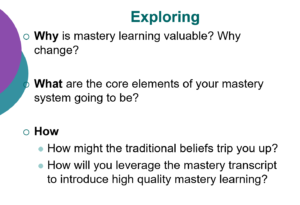
Today, what we will be doing is exploring several questions such as:
Why is mastery learning valuable? Why change?
What are the core elements of your mastery system going to be?
How
- How might the traditional beliefs trip you up?
- How will you leverage the mastery transcript? How will you change your school?
- How will you lead the effort to transform your school?
You most likely have your own questions you want to address during our two days together, so you might want to jot those down on the reflection tool.
—

Our first discussion is about why and how we need to change our schools. Many schools jump into mastery-based learning and start to change structures. The create competency frameworks or change grading without taking the time to lay the foundation of understanding on why the traditional system is problematic and how the mastery system of learning should be designed.
—
 Educators and communities turn to mastery learning for many different reasons. You may be concerned about the emotional health of your students. You may want to find ways to better engage them. You may be concerned about inequity and that too many students aren’t learning what they need to know to be successful. You may be concerned about the economy and want to make sure students are being effectively prepared.
Educators and communities turn to mastery learning for many different reasons. You may be concerned about the emotional health of your students. You may want to find ways to better engage them. You may be concerned about inequity and that too many students aren’t learning what they need to know to be successful. You may be concerned about the economy and want to make sure students are being effectively prepared.
What we all have in common is that we have come to the conclusion that the traditional system is getting in our way. We simply can’t get where we want to go with the traditional system. It was designed in a different cultural, historical, economic, and technological time to serve different purposes.
We have learned over the last 10 years that if we aren’t familiar with the flaws in the traditional system, they come back up and bite us. They undermine the quality of the design and our implementation. To fail to address the beliefs and values that are the foundation of the traditional system is the same as rehabbing a house that is built on a very shaky foundation. Things might be a little bit better, but soon windows won’t be closing properly and water will be leaking into the basement.
For example, the traditional system is built on the belief that intelligence is set in stone; that some students are going to learn and others not so much, so there. This means there is very little teachers can actually do to change the learning and life trajectories of students. We deliver a curriculum and then rank and sort students to determine who gets to go to college. If we don’t challenge the assumption that we know who is smart and who isn’t, that intelligence is fixed, and that schools have responsibility for doing the job for colleges of ranking students, we won’t invest enough in helping the more vulnerable students to learn and we’ll create grading systems that continue to be used to rank students rather than help them focus on their learning.
Another aspect of the traditional system is the belief that students are empty vessels to be filled with knowledge so the job of teachers is delivering curriculum rather than teaching students. A culture of compliance and extrinsic motivation is required to try to get students to do what we want them to do because learning isn’t particularly engaging or fun.
One of the leadership skills that is needed is to identify when these different types of traditional beliefs kick in and become very, very skilled at asking questions to help our colleagues challenge their own beliefs and consider new ones. It’s nearly impossible to change someone’s belief by talking at them. They need be invited to reflect on and test their beliefs in a safe environment.
—

So what do we replace it with? That’s what mastery learning is all about.
Although it would be great to have, there is no road map for mastery-based learning. At least not yet. We have a pretty good idea of what it should look like, but I’m pretty sure we need to keep working on the overall design. We are still learning.
To help deal with this problem of not having a road map, CompetencyWorks (in 2018 and with the help of practitioners and researchers) developed a logic model to help us think more clearly about what needs to be in place if we want all kids to succeed and that they can actually apply their knowledge and skills.
The logic model starts with clarifying your student success outcomes. What are the knowledge, skills, and traits you want your students to have when they leave your school? It then identifies two main drivers. One is the research on learning and development and the other is committing to equity.
Part of the reason it is proving difficult to create a road map is that there are mediating factors that shape your school and your path forward – these are based on your students and local context.
—

Let’s consider the student success outcomes and their implications for your design of your mastery-based learning. What do you want students to know and be able to do by the time they graduate? Your school design and the pedagogy need to be designed in a way that reaches these outcomes.
Most likely, you have some mix of these three types of knowledge and skills:
- Academic knowledge and skills will always be important. However, there are some schools and organizations that emphasize skills to such a high degree that knowledge almost disappears from their discussions. This can results in three different kinds of problems: first it is likely that there will be a backlash from parents who value the traditional education system. Second, you are going to risk dumbing down as students may be developing analytical tools without familiarity with the academic concepts. Their analytical skills may stay at a lower level unless they can engage in greater complexity. Third, there is a risk that you are contributing to inequity. Students need to be able to know, remember, and retrieve knowledge easily. Otherwise, they are spending some of their working memory trying to refresh and retrieve concepts when they need it for complex analysis or problem-solving. Investing in helping students learn how to learn facts and concepts is very, very important.
- We know that students need to know how to apply or transfer those skills. They need to know how to use knowledge. They need opportunity to practice, and teachers need to have the capacity to assess at these deeper levels.
- Lifelong learning is a phrase that captures a number of different types of skills and traits. Some schools focus solely on habits and traits such as time management and perseverance. Others might use the term agency or voice or choice. But it is so much more than that. The skills to own one’s own learning means that one can manage one’s thinking and feelings. It includes growth mindset, metacognition, and self-regulation. I’ll refer you to Building Blocks for Learning at Turnaround for Children, as they have strongest framework and research base that I’ve found to date.
These types of lifelong learning skills are critical to any school committed to greater equity. To fail to ensure students develop these skills and traits means that they will continue to be dependent learners. Furthermore, these skills change the nature of power in our classrooms. They are giving students the skills to challenge and navigate any environment, including classrooms where teachers are still burdened with the traditional beliefs.
I’m going to pause here to clarify the use of the concept of personalized learning as it overlaps with lifelong learning skills. I am not talking about technology. If I talk about technology, then I use the term technology. In fact, I’m not going to talk about technology at all… I am talking about personalized learning as a counter concept to the idea of one-size-fits-all or a cookie-cutter approach to education where all students receive the same curriculum and are expected to learn at exactly the same pace. And I am talking about personalized learning in terms of the building blocks for learning.
It’s personalized because it works for me and it’s personalized because I own it – it’s my mind and my education. Personalized learning means schools are responsible for teaching students all the lifelong learning skills, even at high school.
—
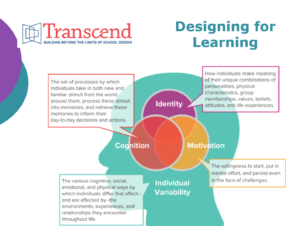
Now let’s talk about the research on learning and development. I use the word research, not science of learning, as we are still learning about learning. There are gaps in our knowledge. For example, we have a lot more we need to learn about how facts and memories are retrieved. Furthermore, the cognitive science research has been developed within different fields such as neuroscience and education psychology. It’s left to educators to figure out how to build their professional knowledge of how to use different findings from different fields.
Based on all my school visits, I truly believe that it helps immeasurably if schools develop a clear set of core pedagogical principles before they dive too far into implementation. The research helps to keep the WHY we are transitioning to mastery learning clear and opens up a very different level of dialogue among educators that is focused on “what’s best for kids” and not introducing a practice because a paper said to or because other schools are doing it. It aligns your decision-making with “what’s best for kids” and helps you pay attention to quality in everything you do.
The research on learning is an enormous field with lots and lots of findings, so districts and schools will need to engage teachers in creating a way to make sense of the research. Here is one example. In their paper Designing for Learning, Transcend outlined four main areas of research: cognition, identity, motivation, and individual variability with key findings under each one.
—
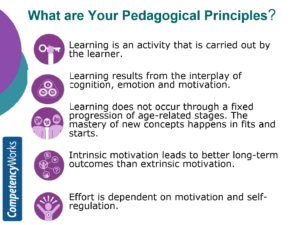
I highly recommend the Transcend paper for a solid summary of the research on learning and development.
However, for our work today, this model developed at CompetencyWorks is a simpler model while still drawing from multiple fields of research. At LearningEdge, you can also find an article with several different resources available on the research on learning and development.
Many of these findings challenge the beliefs of the traditional system. And they definitely put into question the practices of the traditional high school classroom.
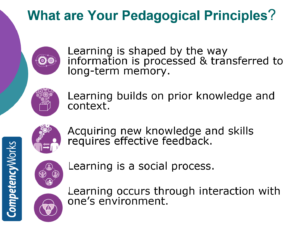
Let’s take a look at a few of these findings:
The first one is learning is an activity that is carried out by a learner. Learners have to be actively involved and engaged. The fourth one is that the effort we put forth is dependent on motivation and self-regulation. The fifth one refers to the research on how we process information from working memory to long-term memory that takes into consideration prior knowledge, the fact that we can only work with a maximum of 7 concepts at a time, and that we need practice to encode information.
So why do we think that students are going to be learning just by listening to a teacher talk, taking notes, and periodically being asked to answer a few questions? What the research tells us is that we need to design learning experiences so that students are actively challenged, that we need to provide information in bite-sized pieces with time to allow for students to process and practice, and that we need to pay attention to the conditions of the classroom and school so that students feel safe and aren’t spending their working memory worrying about whether something negative might happen to them. Even in high school, we should be coaching students on metacognition and emotional self-regulation if it is getting in their way of learning.
The quiz is a fascinating and illuminating example about how the traditional system can negatively influence the learning experience. A quiz used as a technique to help students discover what they know and where they need to focus is a powerful tool. In the traditional system that believes that the grade, or extrinsic motivation, is what will inspire students to put forth their best effort, the quiz becomes ineffective. Summative grading may actually diminish motivation and effort. Students will be more motivated and put in more effort if they feel they will eventually be successful. Being judged might lead to students shutting down if they start to feel afraid and not having an opportunity to continue learning will diminish intrinsic motivation.
I want to make one other comment about the research on learning. There is substantial research on how we think and how we retrieve ideas. This research is showing us how bias just jumps into our minds without our even knowing it. And is helping us to understand how we might slow our thinking down and help each other identify bias when it does appear. Thus, this research on learning can help adults reduce implicit bias that is negatively impacting our relationships and our instruction with students.
—

Now it’s your turn to actively work and learn. I’ve designed this so that you can fully participate whether you are brand new to mastery learning or have several years under your belt.
Take out Template #2 that says Intentionality and Alignment. First, you need to organize yourself with a scribe who will be responsible for filling in a template for the group, a time keeper to help you all keep moving along, and a facilitator to make sure everyone is contributing.
Your task is to consider the broad set of student outcomes mentioned on Slide 3 and the 10 findings about learning shared on Slides 5 and 6 and begin to identify the most important practices in your school that should be stopped or done less of, as well as which things you need to start doing.
Then push yourself to think about what your teachers will need to support them to make these changes and, as you implement, whether some of the traditional beliefs or practices on Slide 1 might trip you up and undermine quality.
So each of you should take 2 minutes to think of a few examples of what you should stop and start doing and then work together as a group to come up with 2 or 3 examples.
—

Take 2 minutes to process. Grab your Basket of Reflections or whatever you want to write on and capture your a-ha!, what you want to take back to your school, what things you want to follow up on, and what questions are percolating.
—
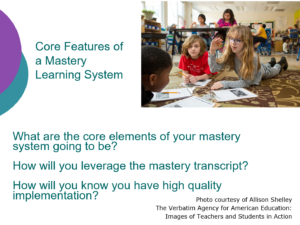
That first section was designed to explore the importance of and the analytical capacity you will need to build to always check back with your outcomes and the research on learning as you make decisions.
Now we are going to look at how you might leverage the Mastery Transcript to put into place core features and then challenge yourself to do it in a way that it is high quality.
—

The Mastery Transcript is considered a high-leverage practice because it both communicates that something is changing and it is systemic in that it requires other parts of the education system, namely colleges, to change as well AND for schools, you can’t fully implement the mastery transcript without implementing core features of a system of mastery learning in your schools.
- The core idea is to put the focus on learning.
- Broad set of student success outcomes that emphasize knowledge and skills.
- Students will need to demonstrate their learning; A-Fs won’t be used.
- More personalized with students able to pursue learning and demonstrating their learning within high interest contexts.
But if we want a Mastery Transcript, what else needs to be in place?
—
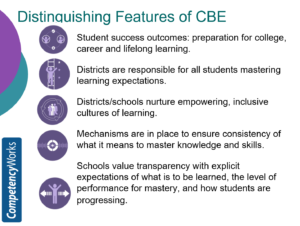
CompetencyWorks, with the help of 100 practitioners, identified what we think are the distinguishing features. Remember, there are other features of high performing schools and districts. We think these are 10 features that are important to implement with quality.
I’m going to highlight a few that I think are particularly important.
The second one states that districts and schools are committed to making sure that all students master the learning expectations. This means two things: You don’t just pass kids on with gaps. Nor do you retain them. It assumes that a record of what students have mastered and not is available to teachers and that there are plans for how you help students master the material in the near future. Second, it means continuous improvement with a strong focus on equity. Which students didn’t master the material, why not, and how do you need to change so that the next cohort will?
The third feature is about empowering inclusive cultures of learning. We debated this a lot – a high-achieving culture is important for any school. Most of the literature on high-achieving culture emphasized order. One book suggested that having a relationship with the police is an indicator of a strong culture of safety – but not if you are young man of color. In looking at the research, it became clear that schools need to pay attention to making sure everyone feels like they are included and belong. If you don’t, you don’t feel safe. If you don’t don’t feel safe – if you have fear – your amygdala is going to be activated and will impact learning. We also determined that an empowering leadership style is important – because if students are going to have agency, you better make sure teachers do, as well.
The fourth feature is about consistency… How do you make sure that within your school, teachers are determining mastery with the same expectations? How do you make sure that there is consistency across schools in a district? If there isn’t the same consistent expectations held, we fall right back into inequitable practices with students being passed along without learning what they need to in order to be successful in the next step of their education.

For each of your schools that want to implement a Mastery Transcript, you are going to have to think through the core features and decide what practices might need to be put into place to make the Transcript functional.
Let’s look at two examples:
If you want every student to be able to master the knowledge and skills in a course, you probably are going to need several ways to provide timely and differentiated instruction. Many schools have flex hours during the day. Others put a few days at the beginning or end of a semester for more individual support to students. Or you could do both. Or you might think of other ways of creating a rapid response.
Here is another example:
If mastery transcripts mean that students are going to be demonstrating knowledge within high interest areas, you will need to have capacity within your school to assess knowledge consistently. Time will have to be dedicated for teachers to moderate their understanding of mastery by looking at student work. They will need to create common rubrics that can be applied to uncommon ways of demonstrating knowledge. The rubrics will be one of the ways that you can communicate those expectations to students.
—
 Now I need to tell you about the problem in the field. It is quality.
Now I need to tell you about the problem in the field. It is quality.
There are lots of districts and schools making the transition to mastery learning, but they are doing so in limited ways and in ways that suggest they don’t understand the foundation that is needed for mastery learning.
Essentially, the design of competency education has been too narrow and/or the implementation too shallow. To try to address this problem, CompetencyWorks produced Quality Principles for Competency Education that offers a framework of 16 quality principles organized by 1) purpose and culture, 2) teaching and learning, and 3) structure.
In this book ,we explain why each of the principles is important, key characteristics, and red flags that there is a quality problem.
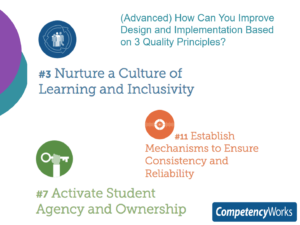
Examples of these quality principles include: Creating a culture of learning and inclusivity; establishing mechanisms to ensure consistency and reliability in determining mastery; and activating student agency and ownership.
We could spend 90 minutes talking about these principles…but we aren’t, as they were sent out as a pre-read. What’s important is to ask the question, In what way is my school fully putting these principles into place and where are there indications that perhaps they aren’t in place? Where is a culture of judgment, ranking, sorting and exclusion still at play? Where is there inconsistency in how we assess mastery, and what are the consequences for students? Where are we expecting students to be motivated solely by carrots and sticks?
It is never too soon to start thinking about quality!
—
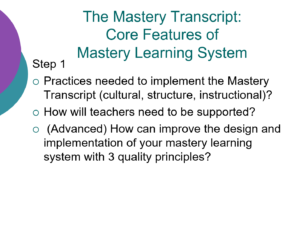
Ready to work? There are 2 parts to this next process. We are going to begin with identifying a few core features of your mastery learning system. In the second part, we will do a fun activity that focuses on how you will do it all.
Take out the Template #3 that Says Core Features of a Mastery Learning System and keep the same role of scribe, timekeeper, and facilitator.
Imagine you are putting together your plan to introduce a Mastery Transcript.
What other practices or strategies need to be in place? Remember – think about school and classroom culture, the structural elements, and strategies related to instruction and assessment.
Your task is to identify 2-3 core strategies that are needed to support the Mastery Transcript. After you identify a few strategies or practices, think about what types of supports teachers will need.
And for those of you who are advanced, I want you to think about those three quality principles: a culture of learning and inclusivity; consistency; and student ownership. How might you think about quality design and implementation of this practice? Where might there be quality problems, and what can you do to minimize them?
Take 2 minutes to work individually to jot down your ideas. Then you will have 10 minutes for 2 examples to come up with as a group.
—
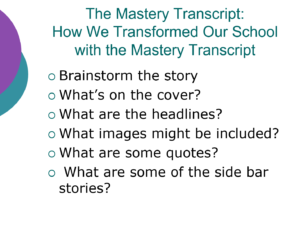
Okay this is the last piece. Grab Template #4.
I want you to jump ahead five years to the year 2024. A magazine has come to interview your school to find out how you have successfully implemented the Mastery Transcript and a system of mastery learning. Your task is to create a magazine cover for 5 years from now that is all about how your school(s) made the transformation to mastery-based learning.
Start this process by quickly brainstorming 3-5 aspects of the story. See where you can jot down your ideas where it says brainstorm?
Then you can fill in:
- What’s on the cover of the magazine?
- What are the headlines?
- What images might be included?
- What are some quotes? From different stakeholders – parents, students, college admissions, the governor?
- What are some of the side bar stories? What was really interesting? What was really challenging? What obstacles did you have to overcome?
If you want you can turn the paper over and create your magazine cover!
You’ve got 15 minutes! Jump right in there.




One response to “A Conversation on the Why, What, and How of Mastery Learning”